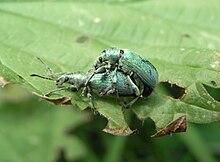| Phyllobius glaucus | |
|---|---|

| |
| Scientific classification | |
| Domain: | Eukaryota |
| Kingdom: | Animalia |
| Phylum: | Arthropoda |
| Class: | Insecta |
| Order: | Coleoptera |
| Suborder: | Polyphaga |
| Infraorder: | Cucujiformia |
| Family: | Curculionidae |
| Genus: | Phyllobius |
| Species: | P. glaucus |
| Binomial name | |
| Phyllobius glaucus (Scopoli, 1763) | |
Phyllobius glaucus is a species of weevil found across Europe, especially in carrs. It is a pest of a variety of fruit trees, but has little economic effect. It was first described by Giovanni Antonio Scopoli in 1763.
Description
Adults grow to 8–12 millimetres (0.3–0.5 in) long. The body is black, but is covered with elongate, hair-like scales that give the animal a very variable, greenish-brown appearance. The legs are reddish brown.
Distribution
Phyllobius glaucus is common and widespread in Europe. A single specimen of P. glaucus (under the name P. calcaratus) has been recorded from Canada, but this is thought to be an error.
Ecology and life cycle

Phyllobius glaucus is associated with a wide range of trees and shrubs, and is a minor pest of fruit trees, including apples, pears, cherries and plums. The insects chew small holes in the leaves and petals of the trees. It is a typical component of the fauna of alder carr in northwestern Europe.
Taxonomic history
Phyllobius glaucus was first described by Giovanni Antonio Scopoli in his 1763 work Entomologia Carniolica, under the name Curculio glaucus. A second species was later named Curculio glaucus, but has since been renamed to Coniocleonus glaucus. Taxonomic synonyms of Phyllobius glaucus include:
- Curculio glaucus Scopoli, 1763
- Curculio coelestinus Scopoli, 1763
- Curculio carniolicus Gmelin, 1790
- Curculio calcaratus Fabricius, 1792
- Phyllobius calcaratus (Fabricius, 1792)
- Curculio caesius Marsham, 1802
- Curculio cnides Marsham, 1802
- Phyllobius atrovirens Gyllenhal, 1834
- Phyllobius alneti C. G. Thomson, 1859
- Phyllobius maculatus Tournier, 1877
- Phyllobius nudus Westhoff, 1882
- Phyllobius densatus Schilsky, 1886
- Phyllobius schilskyi Faust, 1890
- Phyllobius nigripes Gerhardt, 1900
- Phyllobius nigrofemoratus Gabriel, 1900
- Phyllobius fuscofumosus Reitter, 1906
- Phyllobius tibialis Schilsky, 1908
- Phyllobius pseudodensatus Reitter, 1916
Further reading
- Giovanni Antonio Scopoli (1763). Entomologia Carniolica. Vienna: Thomas von Trattner.
References
- ^ D. V. Alford (2007). "Phyllobius glaucus (Scopoli)". Pests of fruit crops: a color handbook. Plant protection handbook series. Elsevier. p. 165. ISBN 978-0-12-373676-5.
- ^ M. A. Alonso-Zarazaga (2008). "The types of Palaearctic species of the familia Apionidae, Rhynchitidae, Attelabidae and Curculionidae in the collection of Étienne Louis Geoffroy (Coleoptera, Curculionoidea)" (PDF). Graellsia. 64 (1): 17–44. doi:10.3989/graellsia.2008.v64.i1.52. hdl:10261/23431.
- ^ "Curculio glaucus (Scopoli, 1763)". Fauna Europaea. June 3, 2010. Archived from the original on June 22, 2011. Retrieved June 24, 2010.
- Donald E. Bright & Patrice Bouchard (2008). "Genus Phyllobius Germar, 1824". Weevils of Canada and Alaska: Coleoptera, curculionidae, entiminae. Part 25 of Insects and arachnids of Canada. NRC Research Press. pp. 151–155. ISBN 978-0-660-19400-4.
- Scott A. Elias, Lucy Webster & Marc Amer (2009). "A beetle's eye view of London from the Mesolithic to Late Bronze Age". Geological Journal. 44: 537–567. doi:10.1002/gj.1158.
- Marek Wanat (2005). "Phyllobius fessus Boheman, 1843, a new weevil species in Poland and Lithuania (Coleoptera: Curculionidae)" (PDF). Genus. 16 (4): 611–617.
| Taxon identifiers | |
|---|---|
| Phyllobius glaucus |
|
| Curculio glaucus | |